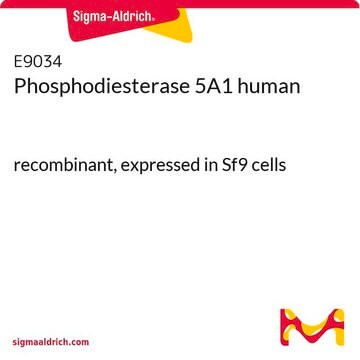G1642
sn-Glycerol-3-phosphocholine Phosphodiesterase from mold
lyophilized powder, ≥5 units/mg protein
Synonym(s):
Glycerophosphorylcholine phosphodiesterase from mold
Sign Into View Organizational & Contract Pricing
All Photos(1)
About This Item
CAS Number:
MDL number:
UNSPSC Code:
12352204
NACRES:
NA.54
Recommended Products
form
lyophilized powder
specific activity
≥5 units/mg protein
composition
Protein, ~40% Bradford
storage temp.
−20°C
Unit Definition
One unit will produce 1.0 μmole of choline from L-α-glycerophosphorylcholine, G4007, per min at pH 8.0 at 37 °C.
Physical form
Lyophilized powder containing Tris buffer salt
Storage Class
11 - Combustible Solids
wgk_germany
WGK 3
flash_point_f
Not applicable
flash_point_c
Not applicable
ppe
Eyeshields, Gloves, type N95 (US)
Certificates of Analysis (COA)
Search for Certificates of Analysis (COA) by entering the products Lot/Batch Number. Lot and Batch Numbers can be found on a product’s label following the words ‘Lot’ or ‘Batch’.
Already Own This Product?
Find documentation for the products that you have recently purchased in the Document Library.
Carmelina D Anfuso et al.
Lipids, 38(1), 45-52 (2003-04-03)
In pericytes from bovine retina, the enzyme glycerophosphocholine phosphodiesterase, catalyzing the hydrolysis of sn-glycero-3-phosphocholine to glycero-3-phosphate and choline, has been characterized with respect to pH optimum, metal ion dependence, Km, inhibitors, and subcellular localization. In these cells, the natural substrate
C D Anfuso et al.
Comparative biochemistry and physiology. Part B, Biochemistry & molecular biology, 112(3), 493-501 (1995-11-01)
While steady-state kinetic parameters (metabolite pools, Km and activation energies) are partially known for the enzymes involved in phosphatidylcholine synthesis and degradation in mammalian brain, they are not available for the nervous system of lower vertebrates or invertebrates. Since the
Mária Simocková et al.
The Journal of biological chemistry, 283(25), 17107-17115 (2008-04-25)
The product of the open reading frame YPL206c, Pgc1p, of the yeast Saccharomyces cerevisiae displays homology to bacterial and mammalian glycerophosphodiester phosphodiesterases. Deletion of PGC1 causes an accumulation of the anionic phospholipid, phosphatidylglycerol (PG), especially under conditions of inositol limitation.
J Yuan et al.
Neurochemical research, 19(1), 43-48 (1994-01-01)
An enzyme releasing phosphocholine from glycerophosphocholine was purified to apparent homogeneity based upon SDS-PAGE. The enzyme was liberated from lyophilized bovine myelin by differential detergent extraction and final purification was accomplished with Q-Sepharose Fast Flow chromatography yielding an apparently homogeneous
J N Kanfer et al.
Neurochemical research, 18(3), 331-334 (1993-03-01)
Previous studies have demonstrated elevated brain levels of phosphomonoesters in early stages of Alzheimer's disease and elevations of phosphodiesters later in the disease. In addition, preliminary quantitative analyses of the phospholipids of Alzheimer's brain reveals either decreases in some phospholipids
Our team of scientists has experience in all areas of research including Life Science, Material Science, Chemical Synthesis, Chromatography, Analytical and many others.
Contact Technical Service








